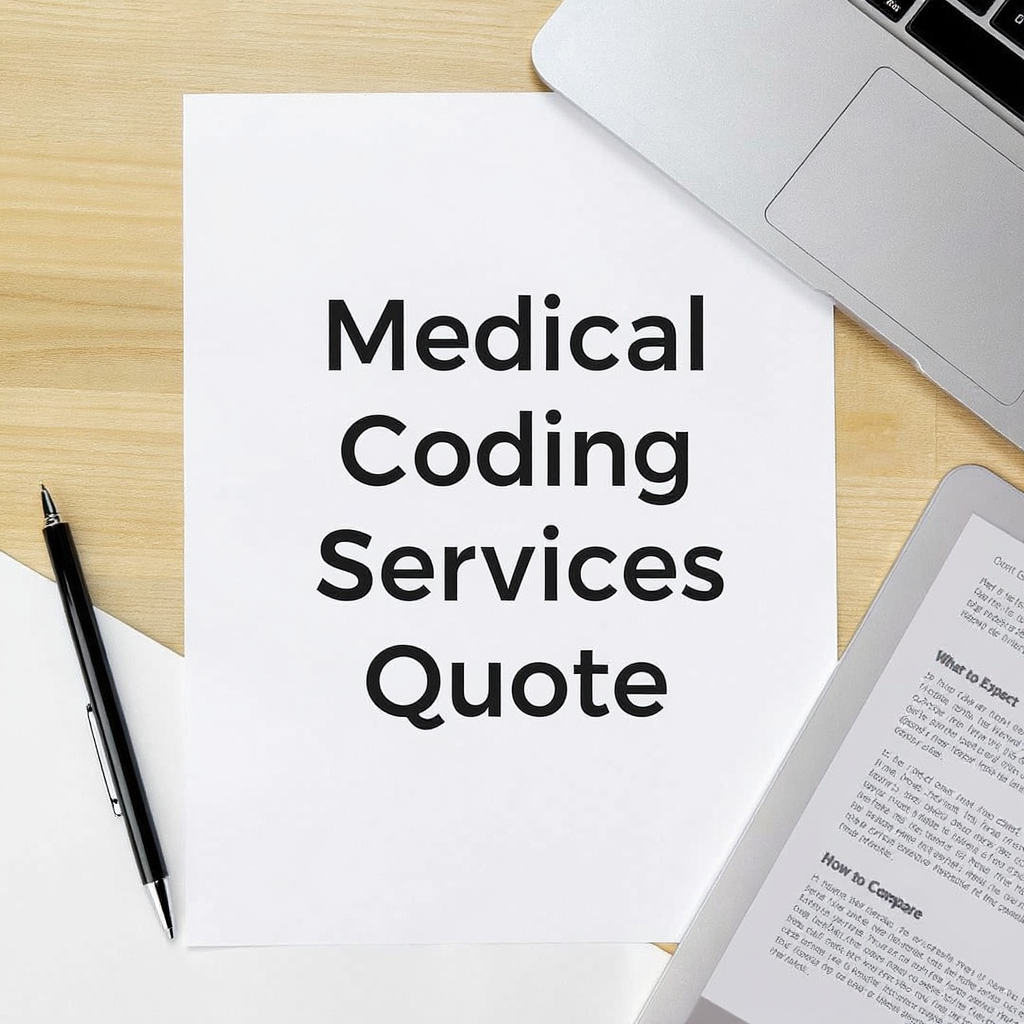Greetings! Navigating the Medical Coding Services Quote Odyssey: What to Expect and How to Compare
Medical Coding Services
Medical Coding Services
In the fast-paced world of healthcare, where accuracy is paramount and efficiency is the mantra, medical coding stands as the silent backbone that sustains the financial viability of any practice. From small practices to large hospital systems, translating diagnoses, procedures, and services into standardized alphanumeric codes is critical for proper reimbursement and regulatory compliance. Without accurate medical coding, healthcare providers face payment delays, claim denials, and, in the worst cases, audits and legal penalties.
The increasing complexity of codes (ICD-10-CM, CPT, HCPCS), documentation guidelines, and ever-evolving regulations make medical coding a specialized task that often exceeds the capabilities of in-house teams. This is where outsourced medical coding services come into play, offering an expert solution to optimize the revenue cycle and ensure the financial health of your practice. However, obtaining a quote for these services and effectively comparing them can be a complex process.

This blog delves into the world of medical coding service quotes, breaking down what to expect, the factors that influence costs, and, most importantly, how to compare quotes to make an informed decision that will benefit your practice in the long run.
Understanding the Importance of Accurate Medical Coding
Before diving into quotes, it’s crucial to reiterate why medical coding is so vital. It’s not simply an administrative exercise; it’s a critical function that directly impacts cash flow, revenue cycle management, and the overall financial stability of a healthcare institution.
The Pillars of Successful Medical Coding
Accurate Reimbursement: Medical codes are the basis for determining how much a healthcare facility will be paid for services rendered. When codes are accurate and align with the services provided, facilities receive full and timely payments. Recent studies indicate that practices with accurate coding experience a 15-20% increase in billing compared to those with high error rates.
Reduction in Claim Denials and Rejection: Incorrect codes or improperly documented services are the leading causes of claim denials or rejections. This leads to payment delays and requires additional resources to correct and resubmit claims, increasing administrative costs. A typical practice can spend up to $25–30 per denied claim in reprocessing costs alone.
Regulatory Compliance: Proper coding helps avoid penalties and legal issues due to incorrect billing or coding, including violations of laws like HIPAA and the False Claims Act. Noncompliance can result in fines, penalties, and even lawsuits. Audits for improper coding have resulted in fines ranging from $10,000 to several million dollars, depending on the magnitude of the problem.
Revenue Optimization: Accurate coding maximizes the amount reimbursed for each service, reducing the risk of underpayments and ensuring that healthcare providers receive the full amount owed. Improper upcoding and downcoding can cost an average practice between 5% and 15% of its potential revenue.
Improved Cash Flow: With faster payments and fewer errors, a healthcare facility can better manage its cash flow, ensuring sufficient working capital to invest in new technologies, staff, and services.
The Cost of Poor Coding
The consequences of inadequate medical coding go beyond immediate financial problems. A practice with poor coding may experience:
- More frequent audits: Insurers and Medicare are increasing oversight of practices with suspicious coding patterns.
- Reputation damage: Compliance issues can affect the ability to participate in insurance networks.
- Staff stress: Constant mistakes create frustration and can lead to employee turnover.
- Missed opportunities: Time spent correcting errors is time not invested in growing and improving your practice.
Given this importance, choosing the right medical coding partner is a strategic decision that should not be taken lightly.
Medical Coding Services Pricing Models: The Basics
When you request a quote for medical coding services, you’ll encounter different pricing models. Understanding them is the first step to an effective comparison. The most common ones include:

1. Percentage of Collections
This is perhaps the most common model in the industry. The coding and billing company charges a percentage of the total amount collected from claims. This percentage typically ranges from 4% to 10%, depending on the volume and complexity of the claims.
Advantages:
- Aligns provider incentives with the success of their practice
- There are no fixed costs, so expenses vary with income.
- The supplier is motivated to maximize collections
Disadvantages:
- Costs can be unpredictable
- It may be more expensive for practices with high revenue volumes
- Less control over operating expenses
2. Fixed Fee per Claim
Under this model, the company charges a flat fee for each claim processed, regardless of its value. Fees can range from a few dollars (e.g., $3 to $7) per claim.
Advantages:
- Predictable and controllable costs
- Ideal for practices with stable volume
- Facilitates budgeting and financial planning
Disadvantages:
- Does not consider the variable complexity of claims
- It may be less economical for high-value claims.
- The provider may prioritize speed over accuracy
3. Fixed Monthly Rate
Less common, this model involves a fixed monthly fee regardless of the number of claims or revenue collected.
Advantages:
- Maximum cost predictability
- Ideal for practices with very high and stable volume
- Allows long-term financial planning
Disadvantages:
- It can be expensive during low volume periods.
- Less flexible to changes in the business
- The supplier may reduce quality if volume exceeds expectations.
4. Hourly Rate
Some companies may charge an hourly rate for time spent on coding tasks. Hourly rates can range from $20 to $35 per hour, depending on the level of experience required.
Advantages:
- Complete transparency in the time-cost relationship
- Ideal for specific projects or consulting
- Allows direct control over the scope of work
Disadvantages:
- Unpredictable costs if volume fluctuates
- Requires closer supervision of the work performed
- It can create incentives to work more slowly.
5. Hybrid Models
Many companies offer a combination of the above models, tailoring the pricing structure to the specific needs of the practice. For example, they might charge a percentage of collections with an additional flat fee for specific services such as denial management.
Examples of Hybrid Models:
- Reduced collection percentage + fixed fee for specialized services
- Monthly base rate + variable percentage based on volume
- Tiered rates based on claim volume
It’s critical to understand each provider’s pricing model and how it aligns with your practice’s volume, claim types, and financial goals.
Factors Influencing the Cost of Medical Coding Services
The price of medical coding services is not one-size-fits-all. Several factors contribute to the variation in quotes:
Factors Related to Practice
Claims Volume and Practice Size: Generally, practices with a higher claim volume can negotiate lower fees per claim or a lower percentage of collections due to economies of scale. A practice that processes 10,000 claims per month will have more negotiating power than one that processes 500.
Specialty and Complexity: Certain medical specialties require a higher level of coding expertise due to the complexity of the procedures and diagnoses.
- High Complexity: Cardiovascular surgery, neurosurgery, radiation oncology (8-10% of collections)
- Medium Complexity: Orthopedics, gastroenterology, cardiology (6-8% of collections)
- Low Complexity: Family medicine, pediatrics, internal medicine (4-6% of collections)
Payer Mix: The mix of insurers your practice works with significantly influences costs:
- Medicare: Generally more predictable but with lower reimbursements
- Medicaid: May require prior authorization and additional documentation
- Commercial Insurance: Better reimbursement but more variable rules
- Workers’ Compensation: High administrative complexity and lengthy follow-up
Service Factors
Scope of Services Included: A quote may vary significantly depending on the services included:
- Basic Services: Coding and Claims Filing Only
- Intermediate Services: Includes denial management and basic A/R tracking
- Full Services: Eligibility verification, pre-authorization, complete A/R management, detailed reporting, consulting
Level of Technology and Automation: Companies that invest in advanced technology can offer:
- AI-assisted coding
- Real-time API integration
- Automated performance dashboards
- Proactive error detection
Supplier Factors
Company Experience and Reputation: Established companies with a proven track record may charge premiums 10-20% above the market average, but this investment often translates into:
- Lower denial rates (2-3% vs. 8-12% industry average)
- Faster payment times
- Better regulatory compliance
- Superior customer support
Geographic Location and Operational Structure:
- Domestic Suppliers: Higher Rates but Easier Communication and Compliance
- Offshore Suppliers: Costs 20-40% Lower but Possible Communication Barriers
- Hybrid Suppliers: Combine domestic and offshore operations to balance cost and quality
What to Expect When Requesting a Quote for Medical Coding Services
The Initial Assessment Process
When you embark on the quote request process, expect a professional, consultative approach. A reputable coding company will want to thoroughly understand your practice to provide an accurate quote.
Initial Consultation and Discovery: Most companies will start with a 30-60 minute call or meeting to understand:
- Your goals and expectations
- Current issues in the revenue cycle
- Approximate budget available
- Desired implementation schedule
Detailed Information Request: Be prepared to provide specific information:
Basic Practice Information:
- Number of suppliers and administrative staff
- Medical specialty(ies)
- Annual visit volume (per month/year)
- Average number of monthly claims
Technical Data:
- Current EHR/Practice Management Software
- Existing billing systems
- Current level of technological integration
- Current reporting capabilities
Financial Information:
- Annual or projected net income
- Your current payer mix with percentages
- Current claim denial rate
- Average payment time (days in A/R)
- Specific collection problems
Professional Analysis and Proposal Development
Analysis Period: The best companies will take 3-7 business days to analyze your data and develop a customized proposal. During this time, they can:
- Conduct comparative analysis with similar practices
- Identify specific opportunities for improvement
- Calculate realistic ROI projections
- Develop a customized implementation plan
Detailed Proposal: A professional proposal should include:
- Executive summary of projected benefits
- Detailed description of included services
- Transparent pricing structure with examples
- Implementation schedule
- Expected performance metrics
- References and relevant case studies
Presentation and Negotiation
Presentation Meeting: The proposal review meeting typically lasts 45-90 minutes and includes:
- Detailed presentation of the proposal
- Question and Answer Session
- Discussion of customizable terms
- Explanation of the implementation process
- Introduction to the team that would work with your account
Negotiation Process: Typically negotiable elements include:
- Fee structure and percentages
- Additional services included
- Terms of the contract
- Guaranteed performance metrics
- Implementation schedule
How to Effectively Compare Medical Coding Services Quotes
1. Total Cost of Ownership (TCO) Analysis
Beyond the Price Tag: A lower quote may not be the best deal if the quality of service is poor. Develop an evaluation framework that includes:
Projected ROI Analysis:
- Calculate the potential impact on collections
- Estimate the reduction in internal administrative costs
- Evaluate the value of freed staff time
- Consider the opportunity cost of coding problems
TCO Calculation Example:
Práctica con $2M de ingresos anuales:
- Opción A: 5% de cobranzas = $100,000/año
- Opción B: 6% de cobranzas = $120,000/año
Si la Opción B aumenta las cobranzas en 3% ($60,000),
el costo neto real es: $120,000 - $60,000 = $60,000
vs. $100,000 de la Opción A

Identifying Hidden Costs: Develop a checklist for additional costs:
- Setup and implementation fees ($500-$5,000)
- EHR/PM Integration Costs ($1,000-$10,000)
- Data migration fees ($500-$3,000)
- Monthly software/platform costs ($50-$500/month)
- Clearinghouse fees ($0.25-$1.00 per claim)
- Charges for specialized services
- Guaranteed minimum monthly rates
2. Detailed Scope of Service Assessment
Service Comparison Matrix: Create a detailed comparison table:
| Service | Supplier A | Supplier B | Supplier C |
|---|---|---|---|
| ICD-10/CPT Coding | ✓ | ✓ | ✓ |
| Electronic filing | ✓ | ✓ | ✓ |
| Denial management | Basic | Complete | Advanced |
| A/R Tracking | 30 days | 45 days | 60 days |
| Eligibility Verification | Additional | Including | Including |
| Real-time reports | No | Yeah | Yeah |
| Telephone support | Limited | 8-5 | 24/7 |
Denial Management Analysis: This is a critical differentiator:
- What percentage of denials are appealed?
- What is your success rate on appeals?
- Are there limits on the number of appeals?
- Do you charge for appeals work?
3. Evaluation of Experience and Credentials
Specialization Check: For your specific specialty, evaluate:
- Years of experience in his medical field
- Number of current clients in your specialty
- Knowledge of specific codes and procedures
- Understanding specialized regulations
Staff Certifications:
- Percentage of certified coders (CPC, CCS, etc.)
- Continuing education programs
- Relevant certification specialties
- Staff turnover and average experience
4. Technology Analysis and Integration
Technology Platform Assessment:
- Do you use industry-leading coding software?
- Do you offer real-time customer portals?
- What level of automation do they employ?
- How do you handle code and regulation updates?
Integration with Existing Systems:
- Native support vs. custom interfaces
- Realistic implementation time
- Technical support during the transition
- Two-way data exchange capability
5. Contractual Terms and Legal Protection
Critical Liability Clauses:
- Liability for coding errors
- Errors and omissions insurance coverage
- Protection against audits and repossessions
- Specific performance guarantees
Contractual Flexibility:
- Termination terms (30, 60, 90 days)
- Penalties for early termination
- Automatic renewal clauses
- Ability to modify services without penalty
Advanced Questions for Potential Suppliers
Questions about Performance and Metrics
- What is your first-time audited coding accuracy rate?
- What performance guarantees do you offer (denial rates, days in A/R)?
- How do you measure and report ROI for your clients?
- Can you provide performance benchmarks for my specialty?
- What metrics do you use to monitor internal quality?
Questions about Technology and Security
- What security certifications do you have (SSAE 18, HIPAA, HITECH)?
- How do you protect against data breaches?
- Do you use artificial intelligence or automation in coding?
- What business continuity plans do you have in place?
- How do you handle regulatory and code updates?
Questions about Support and Relationship
- Who will be our primary contact and what is their experience?
- How do you handle communication during urgent problems?
- How often do you conduct performance reviews with clients?
- What educational resources do you offer to our staff?
- How do you handle changes in our needs or volume?

Warning Signs: What to Avoid
Red Flags in Quotes
- Prices significantly below market without clear justification
- Lack of transparency in the cost structure
- Unrealistic promises of performance improvements
- Excessive pressure to sign quickly
- Lack of verifiable references from current clients
Contractual Problems
- Broad exoneration clauses that eliminate all liability from the supplier
- Restrictive termination terms or excessive penalties
- Lack of specific and measurable performance guarantees
- Vague or unspecified additional costs
- Automatic renewal clauses without the right to review
Conclusion and Best Practices
Finding the right medical coding services partner is a strategic investment in the stability and growth of your practice. A methodical approach to evaluating quotes can make the difference between a successful partnership and costly operational problems.
Steps to a Successful Decision
- Develop Clear Criteria: Before requesting quotes, define your priorities, budget constraints, and performance expectations.
- Holistic Assessment: Don’t rely solely on price. Consider total value, service quality, and strategic fit.
- Reference Validation: Speak directly with current clients, especially those in similar specialties.
- Trial Period: If possible, negotiate a 90-180 day trial period to evaluate actual performance.
- Periodic Reviews: Establish regular quarterly reviews to monitor performance and make adjustments.

The Value of Right Association
A competent medical coding partner goes beyond simply processing claims. They become a strategic extension of your team, providing:
- Financial Stability: More predictable cash flows and higher collections
- Regulatory Compliance: Reducing the Risk of Audits and Penalties
- Operational Efficiency: Freeing up internal resources to focus on patient care
- Sustainable Growth: A Solid Foundation for Practice Expansion
- Peace of Mind: Confidence that critical aspects of the revenue cycle are in expert hands
By prioritizing accuracy, transparency, and strategic alignment, you’ll navigate the odyssey of medical coding services quoting with confidence and ensure a healthier financial future for your practice.
The decision you make today will influence the financial health of your practice for years to come. Take the time to carefully evaluate your options, ask the tough questions, and choose a partner who shares your commitment to healthcare excellence.
Good luck in your search for the perfect medical coding partner!



